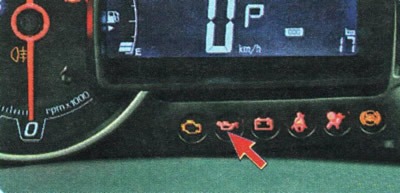
Your vehicle's instrument cluster has an engine oil pressure warning light. For reliable operation of the engine, it is necessary that a sufficiently high pressure is constantly provided in the lubrication system.
Usually, during long-term operation of the car, as a result of wear of the main and connecting rod bearings of the crankshaft, the pressure in the lubrication system gradually decreases. The first sign of severe wear is «winking» signal lamp for emergency oil pressure drop when the engine is idling. Over time, the lamp begins to light up more and more often, and, finally, there comes a moment when at idle it does not go out at all. As a rule, this indicates critical wear of the crankshaft bearings, but other reasons are possible. Therefore, if the emergency oil pressure drop lamp starts to light up when the engine is idling, check the lubrication system (see «Checking the lubrication system»), even if the lamp goes out immediately when the engine speed is increased.
WARNING: If the low oil pressure warning light comes on unexpectedly while the engine is running at high engine speeds (not at idle), you must immediately stop driving, stop the engine and find out the cause. Further operation of the engine with reduced oil pressure can lead to serious damage to it and high financial costs for repairs.
Checking the lubrication system
1. Open the hood. Do not rush to immediately check the engine oil level - let it drain into the oil sump, this will take two to three minutes. During this time, carefully inspect the engine for fresh oil drips.
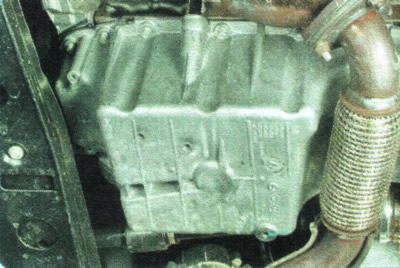
2. Look under the front of the car - if the engine oil sump is broken, if there is a leak.
GOOD ADVICE: If you find an oil leak in a punctured oil sump, try to temporarily fix it in place. In this case, a good result can be obtained by the use of modern repair materials such as «cold welding», available for sale in car dealerships.
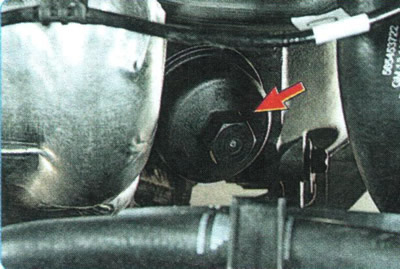
3. Pay attention to the oil filter. Oil may leak from under the rubber o-ring of the filter cover if it is damaged or the cover is loose. Sometimes it is enough to tighten it a little clockwise.
WARNING: Hot engine parts can cause burns, so wear gloves and long sleeves.
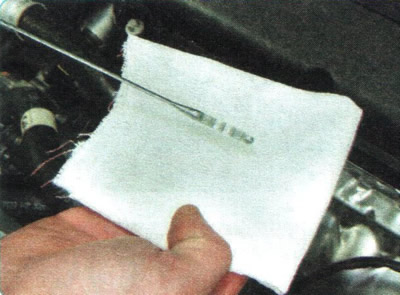
4. Remove the oil dipstick, wipe it with a clean cloth and reinsert. Remove the dipstick again and check the oil level. It should be between the top and bottom marks.
5. If the oil level is below the lower mark, add oil to the norm.
USEFUL ADVICE: In the absence of a funnel for adding oil, you can use a funnel made from a plastic bottle.
6. Start the engine. If the emergency oil pressure drop lamp goes out at a normal level, you can continue driving.
If the lamp does not go out, you will have to call a tow truck, because to check the emergency oil pressure warning light sensor, you must put the car on a lift. The sensor is located at the bottom front of the cylinder block, next to the water pump (under the exhaust manifold and water distribution pipe) and covered with a heat-insulating cover made of aluminum foil.
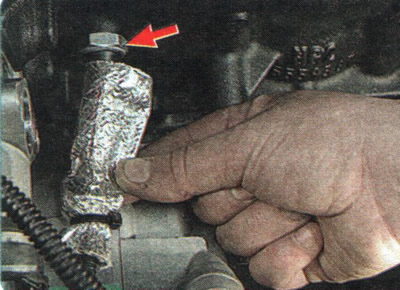
1. Remove the crankcase protection (see «Removal and installation of mudguards and engine crankcase protection»), slide the heat shield and check that the wiring harness connector is securely fastened to the sensor.
2. If the shoe is securely fastened and the warning light is on, try replacing the emergency oil pressure drop warning light sensor with a new one (see «Replacing the oil pressure warning light sensor») and check the signal light circuit (see «Diagnostics of malfunctions of onboard electrical equipment»).
NOTE: If possible, before purchasing a new oil pressure drop warning light sensor, measure the pressure in the lubrication system with a mechanical pressure gauge, which must be installed in place of the inverted sensor. If the pressure at normal idle speed is less than 0.1 MPa, replacing the sensor will not lead to a positive result. It is necessary to diagnose and repair the engine at the service.
3. If it turns out that the oil pressure in the engine lubrication system is insufficient, the cause may be a decrease in the oil pump supply or wear of engine parts. To diagnose and eliminate these malfunctions, you must contact a car service.
